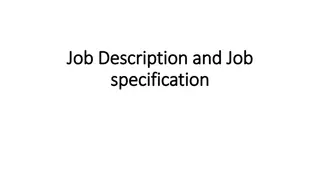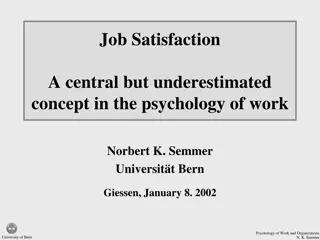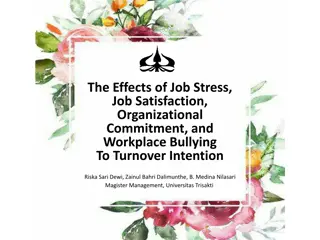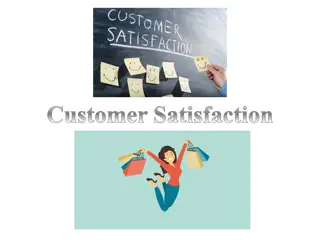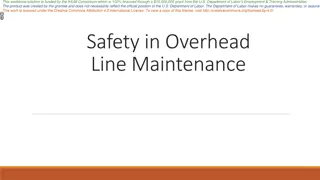Understanding Attitudes and Job Satisfaction in the Workplace
Attitudes play a crucial role in job satisfaction, with cognitive, affective, and behavioral components shaping how employees feel about their work. Major job-related attitudes like job involvement, organizational commitment, and job satisfaction influence employee behavior and performance in the workplace. Recognizing the importance of attitudes in shaping employee engagement and satisfaction is key to fostering a positive work environment.
Download Presentation

Please find below an Image/Link to download the presentation.
The content on the website is provided AS IS for your information and personal use only. It may not be sold, licensed, or shared on other websites without obtaining consent from the author. Download presentation by click this link. If you encounter any issues during the download, it is possible that the publisher has removed the file from their server.
E N D
Presentation Transcript
What is attitude? Attitudes are evaluative statements- either favourable or unfavourable- concerning objects, people or events. They reflect how one feels about something (Robbins and Judge).
The three components of attitudes Cognitive component Affective component Behavioural component
1) Cognitive component It refers to how we think about someone or something The cognitive component is the belief or opinion aspect of the attitude
2) Affective component It is the emotional aspect of the attitude It refers to how we feel about someone or something
3) Behavioural component It is an intention to behave in a certain way toward someone or something It refers to the tendency of a person to behave or act in a certain way.
Importance of attitudes in workplace Employees attitudes have a profound impact on their behaviour It is important to understand how attitudes are formed, how they affect job behaviour and how they can be changed
Major job related attitudes Job related attitudes are the relatively lasting feelings, beliefs and behavioural tendencies that an employee has toward the various aspects of the job 1) Job involvement 2) Organizational commitment 3) Perceived organizational support 4) Employee engagement 5) Job satisfaction
Job involvement The degree to which a person identifies with a job, actively participates in it and considers performance important to self worth
Characteristics of employees with job involvement Identity- high level of belongingness to the organisation Psychological empowerment- employees feel that they are doing a meaningful job and what they do makes a difference to the organisation Participation- high growth needs and enjoy participating in decision making High performance and low absenteeism- rarely late or absent
2. Organisational commitment The degree to which an employee identifies with a particular organisation and its goals and wishes to maintain membership in the organisation
Employees with organisational commitment Accept the values and goals of the organisation Are willing to exert effort for the organisation Have a strong desire to remain with the organisation
Research has found that 1) Higher productivity- modest positive relationship between organisational commitment and productivity 2) Lower absenteeism and turn over 3) Creativity suffers
Relationship between organisational commitment and other variables Higher productivity Moderate positive relationship Negative relationship Lower absenteeism and turnover Creativity (less creativity) positive relationship with low O.C.
Perceived organisational support The degree to which employees believe an organisation values their contribution and cares about their well being
Employees perceive their organisation as supportive when: The reward system in the organisation is fair Participation in the decision making process Managers are supportive and understanding
Employee engagement An individual s involvement with, satisfaction with and enthusiasm for the work he or she does. Employees are very passionate about their work and have a deep connection with the company
Disengaged employees put time but not energy or attention into their work.
Employees develop high levels of engagement if their jobs: Are important and meaningful Allow easy access to resources and opportunities to learn new skills Permit rewarding interactions with co workers and supervisors Give clear guidelines Allow control over performance Are consistent with their identity and training
High levels of employee engagement results in Higher levels of customer satisfaction Sharp drop in customer grievances More productivity and higher profits Reduces employee turnover and lesser accidents at work
Managers classification of employees Enthusiastic stayers Reluctant stayers Enthusiastic leavers Reluctant leavers
Job satisfaction A positive feeling about one s job resulting from an evaluation of its characteristics
Measurement of job satisfaction Single global rating Overall level of job satisfaction is measured Done by using one simple question like how satisfied are you in your work ? It is measured on a five point scale The employee has to select any number between 1 and 5 Facet rating More sophisticated and lengthy In this method, a) The key elements of the job are identified (supervision, nature of work etc.) b) Employee is then asked to rate his feelings for each of the job elements on a standardized scale c) Researchers then add up the ratings on each of the facets to obtain the overall job satisfaction score.
Researchers consider both facet and global rating to be equally effective. Why? 1) The concept of job satisfaction is a broad one that even a single question will make the person understand what it means 2) It is possible that some important facets of job satisfaction are not included in the summation of the score
Advantages of the rating methods Single global rating It is not time consuming Facet rating It helps to identify the factors with which employees are dissatisfied so that they can take quick corrective measures
Determinants of job satisfaction Three major determinants Work itself Pay Personality
1) Work itself High levels of job satisfaction when they enjoy the work When the work is challenging and stimulating than routine Greater satisfaction when there is feed back
2) Pay For poor, pay has a strong relationship with job satisfaction Once a comfortable living is reached, then pay is not very important
3) Personality Individuals who are more happy are generally satisfied Another personality factor that influences job satisfaction is core self evaluation It refers to the person s belief in their inner worth and competence. People high on core self evaluation will be more satisfied in their jobs
The impact of job satisfaction Both job satisfaction and dissatisfaction have a strong impact on the organisation
Exit-voice-loyalty-neglect model According to the exit-voice-loyalty-neglect model dissatisfied employees react in certain ways 1) Constructively or destructively 2) Actively or passively The response of the employee would be an outcome of these two dimensions He may respond in the following ways
Exit-voice-loyalty-neglect model 1) Exit: is an active-destructive response. The employee either quits the organisation or looks for new positions outside 2) Voice: active-constructive response. The employee attempts to improve conditions in the organisation through discussions with superiors 3) Loyalty: passive- constructive process. Employee does nothing but waits for the conditions to improve 4) Neglect: passive destructive response. Employee withdraws himself from the job and allows conditions in the organisation to go from bad to worse
Relationship between job satisfaction and other major variables Job satisfaction and job performance Job satisfaction and organisational citizenship behaviour (OCB) Job satisfaction and customer satisfaction Job satisfaction and absenteeism Job satisfaction and employee turnover Job satisfaction and work place deviance
Job satisfaction and job performance Early belief was that happy workers are productive workers Some researchers feel that it is an illusion for two reasons 1) When we do a good job, we feel good intrinsically 2) Besides high productivity results in greater economic, sociological and psychological rewards in the form of pay raise, greater recognition, promotion etc. This in turn increases our job satisfaction. Studies have found that there is a strong positive correlation between job satisfaction and productivity
Job satisfaction and OCB Factors influencing OCB Employees with job satisfaction are likely to engage in OCB OCB is behaviour that goes beyond what is expected by the organisation 1) Perception of fairness- refers to the employees feelings that the organisation is fair to them with regard to its outcomes, procedures and treatment 2) Good relationship with coworkers 3) Individuals with certain personality traits are more happy at work
Job satisfaction and customer satisfaction Measures that organisations have taken to improve customer satisfaction High job satisfaction leads to an increase in customer satisfaction and loyalty Satisfied employees are more friendly to the customers Dissatisfied customers affect employee satisfaction- they are abusive and rude 1) Training employees 2) Rewarding employees 3) Creating a positive work environment 4) Conducting regular employee satisfaction surveys
Job satisfaction and absenteeism Negative correlation between job satisfaction and absenteeism Satisfied workers report more regularly to work Some organisations have liberal leave policies allowing employees to pursue their passions Absenteeism levels are high when employees have alternative jobs high Job Satisfaction low low high absenteeism
Job satisfaction and employee turnover Factors that influence employee turnover Employment opportunities: when there are alternative employment opportunities they leave Human capital: employees who are high in education and ability are more likely to quit. Employee turnover is the rate at which people leave an organisation There is a negative correlation between satisfaction and turn over
Job satisfaction and work place deviance Dissatisfaction is the root cause of deviant behaviours It is also known as employee withdrawal behaviours Different forms of deviant behaviour 1) Reporting late to work 2) Damaging company property 3) Surfing on the internet during work hours 4) Hostility to co workers 5) Theft in the form of stealing company stationary 6) Substance abuse Reasons for deviant behaviour The feeling that they are exploited The feeling that they are being overworked and not adequately compensated Frustration because of the cold treatment given by the organisation The supervisor is ill treating them and using them as tools to attain organisational objectives Employee deviant behaviours are employees ways of taking revenge, manager must pay attention to the cause of the deviant behaviour
In a nutshell, What is attitude? Components of attitude Major job related attitudes 1) Job involvement 2) Organisational commitment 3) Perceived organisational support 4) Employee engagement 5) Job satisfaction- measurement-determinants- impact of job satisfaction on other variables



